Are Acai Bowls Healthy? We Asked a Nutritionist
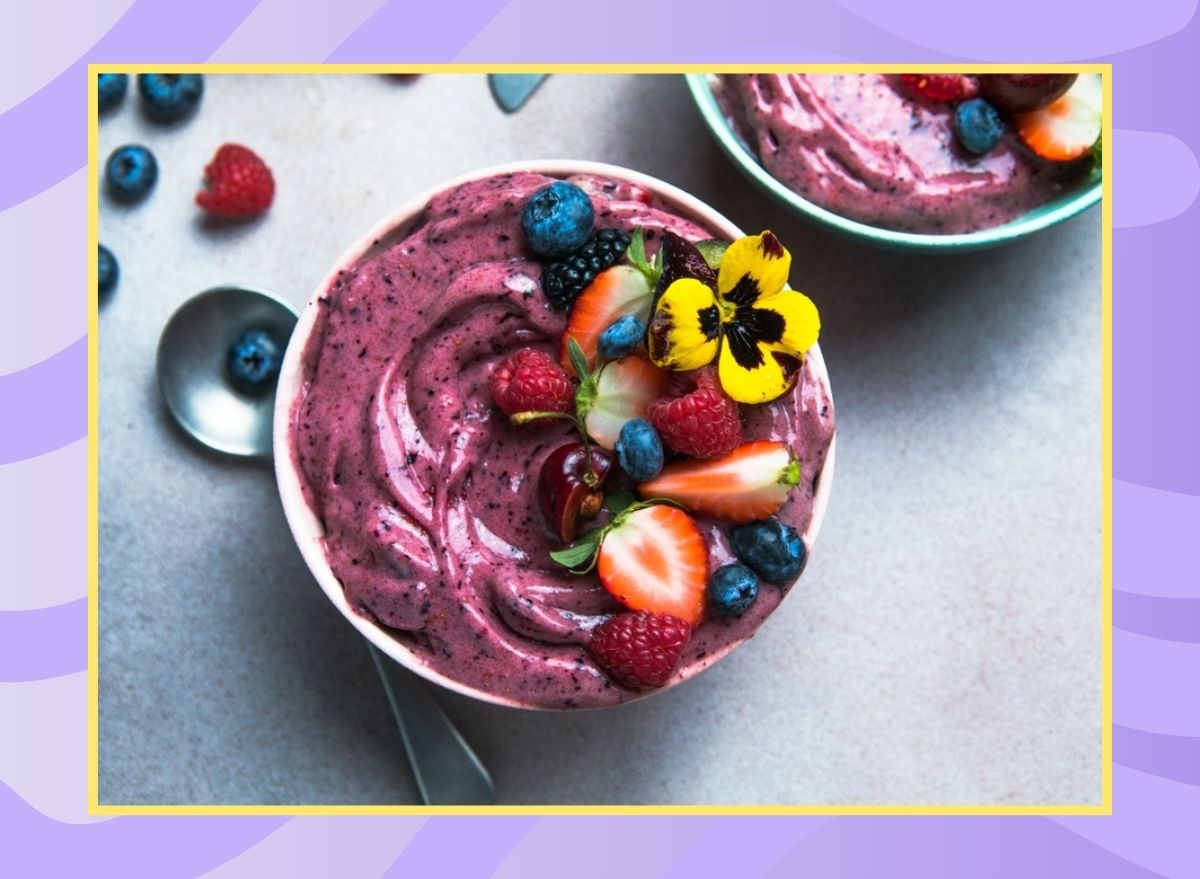
If you’re a fan of berries, you don’t have to limit yourself to the blueberries, strawberries, raspberries, and blackberries you might find at your local grocery store. Another berry that hails from South America has a similar nutrient profile to these mainstream U.S. fruits (though it comes with a different culinary application): the acai berry.
Dark purple-blue in color and bursting with antioxidants, acai berries have found their way into the tasty smoothie bowl trend you may have seen in recipes or at restaurants. Acai bowls are growing in popularity, competing with traditional smoothies to be your healthy breakfast of choice. But how healthy are acai bowls really? As a nutritionist, I’m happy to answer whether acai bowls make a smart choice—at breakfast or any time.
What Are Acai Bowls?
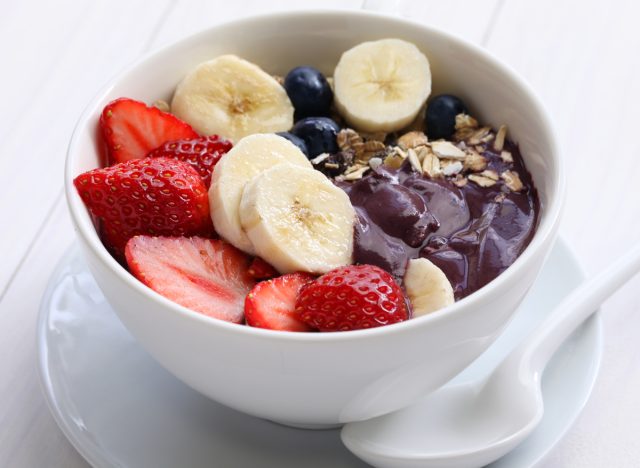
In general, acai bowls begin with a puree of the acai berry, often from a frozen packet. Unlike other berries, acai requires soaking and mashing to make them more palatable. (That’s why you won’t find them sold fresh like blueberries or strawberries). Once pureed, they’re typically frozen, so they’re a handy, creamy base for bowls.
From there, acai bowls add all sorts of toppings, such as other berries, bananas, granola, shredded coconut, or tropical fruits. Authentic Brazilian-style acai bowls are often sweetened with guarana syrup, but sweetening isn’t required. Some acai bowl recipes also call for blending the berry puree with yogurt or juice for extra flavor and a creamier texture.
Nutritional Profile of Acai Bowls
Nutrition can vary widely among acai bowls, especially between restaurant, homemade, and purchased frozen versions. Here’s a look at a couple of options:
At Pressed Juicery, a juice bar chain with locations in multiple states, the Original Acai Smoothie Bowl has the following nutrition:
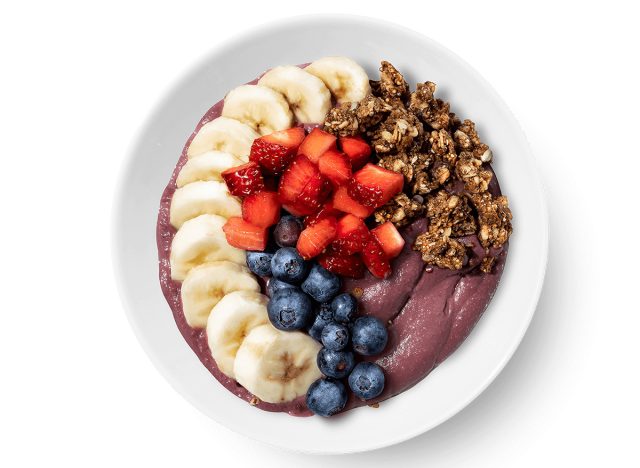
Calories: 390
Fat: 11 g (Saturated fat: 7 g)
Sodium: 180 mg
Carbs: 83 g (Fiber: 7 g, Sugar: 39 g)
Protein: 10 g
On the other hand, an Amazon Superberry Frozen Acai Bowl from Sambazon (available at retailers like Target and Wal-Mart) comes with significantly fewer calories, fat, and sodium:
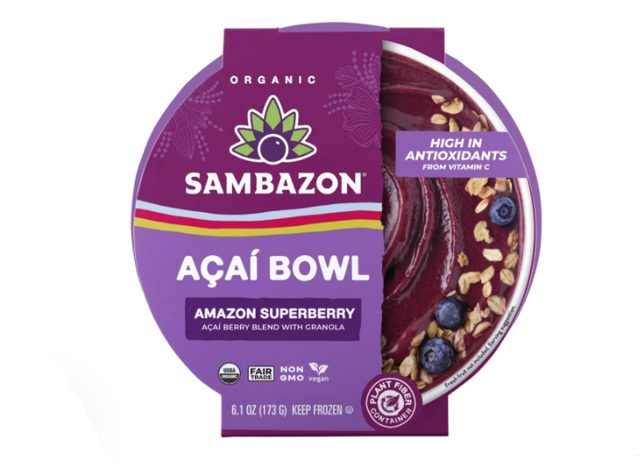
Calories: 230
Fat: 6 g (Saturated fat: 2 g)
Sodium: 30 mg
Carbs: 48 g (Fiber: 4 g, Sugar: 16 g)
Protein: 3 g
Health Benefits of Acai Bowls
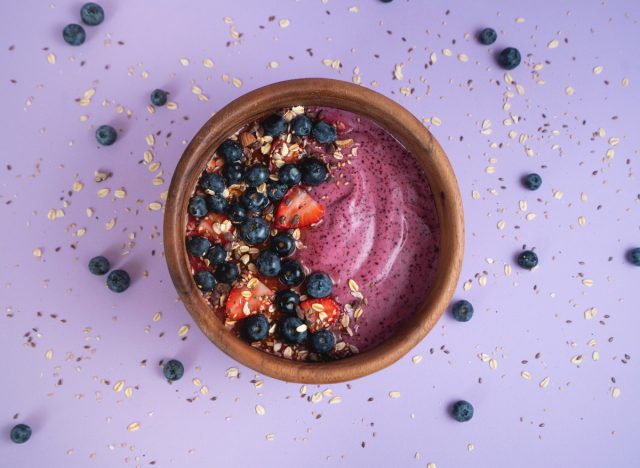
Without a doubt, acai bowls have some health benefits. When you purchase or make your own bowl chock-full of fresh fruit, you’re guaranteed to get a sizable bump of fiber. (A single serving of acai puree has around 3 grams). Getting plenty of fiber is not only associated with healthier digestion, it’s a factor in preventing heart disease, diabetes, and colon cancer.
A 2023 study in the journal Nutrients shed light on more of acai’s potential benefits. These include antioxidant and anti-inflammatory properties that help protect the heart, liver, kidneys, GI tract, and neurological system. Still, the National Center for Complementary and Integrative Health (NCCIH) says there’s no definitive scientific evidence based on human studies to support using acai for health purposes.
As for weight loss—another supposed benefit of acai—the research isn’t so convincing there, either. According to the NCCIH, weight loss claims haven’t been substantiated by studies. Because of this, the Federal Trade Comission (FTC) has even taken legal action against food brands that have deceptively marketed acai as a weight loss aid.
Potential Drawbacks of Acai Bowls
Sunny and bright as they appear, acai bowls do have a wee bit of a dark side. Restaurant and store-bought versions can be extremely high in both natural and added sugars. (Both bowls highlighted above contain 16 grams of added sugar). Some restaurant recipes, like the one at Pressed Juicery, also pack a surprising amount of saturated fat, likely due to the inclusion of coconut cream and granola. This type of fat, when consumed in large quantities, can lead to high cholesterol and an increased risk of heart disease.
Don’t forget, too, that large portion sizes can mean high calorie counts, and even though acai bowls can provide plenty of fiber and energy-boosting carbohydrates, they can also be low in protein.
Are Acai Bowls Healthy?
Long story short, are acai bowls healthy? As with many customizable foods, the answer is “it depends.” If you assemble a properly portioned bowl with healthy ingredients like acai puree, banana slices, whole grain oats, and no added sweetener, you bet it’s good for you! (People with blood sugar issues or on low-carb diets may just need to be mindful of the carbohydrates in an acai bowl).
Then again, if you load your recipe with ingredients like high-calorie granola or added sweetener—or are making a bowl the size of the Amazon basin—the healthfulness of these breakfasts decreases.
Final Recommendations
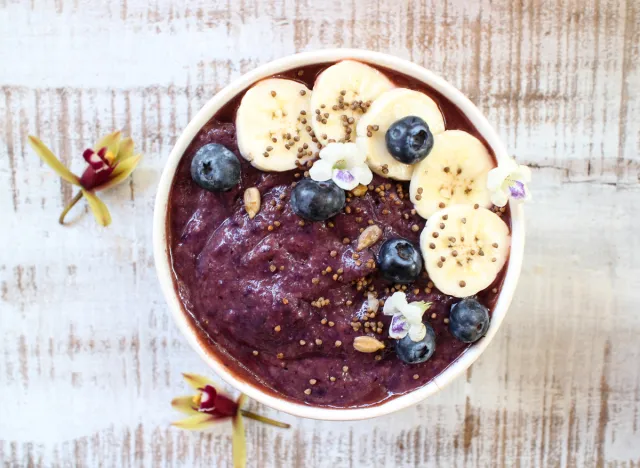
Fortunately, choosing (or making your own) nutritious acai bowl isn’t all that complicated. When purchasing at a restaurant or from a grocery retailer, be sure to look at nutrition info to know what you’re getting. If carbs or sugars seem a bit too high, try eating just half a bowl. Then, supplement the rest of your breakfast or snack with a high-protein choice to slow sugar absorption in your bloodstream. At a restaurant, you may even be able to modify your order, such as asking for no added syrups or leaving off sweetened cereal or granola.
Making your own acai bowl at home? Layer up your colorful breakfast with attention to nutritional detail. Again, this might mean skipping the uber-sweet ingredients or blending your acai puree with Greek yogurt for extra protein. And, of course, stick to a moderate serving size! Big, deep bowls look lovely in photos (and provide plenty of surface area for toppings), but a one-and-a-half-cup cereal-sized bowl is all you need to create a portion-controlled dish that’s still Insta-beautiful.
- Source: https://fdc.nal.usda.gov/fdc-app.html#/food-details/2061549/nutrients
- Source: https://www.mayoclinic.org/healthy-lifestyle/nutrition-and-healthy-eating/in-depth/fiber/art-20043983
- Source: https://www.cdc.gov/diabetes/healthy-eating/fiber-helps-diabetes.html
- Source: https://www.ncbi.nlm.nih.gov/pmc/articles/PMC10488173/
- Source: https://www.ncbi.nlm.nih.gov/pmc/articles/PMC9965320/
- Source: https://www.nccih.nih.gov/health/acai
- Source: https://www.heart.org/en/healthy-living/healthy-eating/eat-smart/fats/saturated-fats